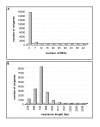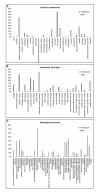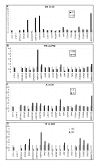MELOGEN: an EST database for melon functional genomics
- PMID: 17767721
- PMCID: PMC2034596
- DOI: 10.1186/1471-2164-8-306
MELOGEN: an EST database for melon functional genomics
Abstract
Background: Melon (Cucumis melo L.) is one of the most important fleshy fruits for fresh consumption. Despite this, few genomic resources exist for this species. To facilitate the discovery of genes involved in essential traits, such as fruit development, fruit maturation and disease resistance, and to speed up the process of breeding new and better adapted melon varieties, we have produced a large collection of expressed sequence tags (ESTs) from eight normalized cDNA libraries from different tissues in different physiological conditions.
Results: We determined over 30,000 ESTs that were clustered into 16,637 non-redundant sequences or unigenes, comprising 6,023 tentative consensus sequences (contigs) and 10,614 unclustered sequences (singletons). Many potential molecular markers were identified in the melon dataset: 1,052 potential simple sequence repeats (SSRs) and 356 single nucleotide polymorphisms (SNPs) were found. Sixty-nine percent of the melon unigenes showed a significant similarity with proteins in databases. Functional classification of the unigenes was carried out following the Gene Ontology scheme. In total, 9,402 unigenes were mapped to one or more ontology. Remarkably, the distributions of melon and Arabidopsis unigenes followed similar tendencies, suggesting that the melon dataset is representative of the whole melon transcriptome. Bioinformatic analyses primarily focused on potential precursors of melon micro RNAs (miRNAs) in the melon dataset, but many other genes potentially controlling disease resistance and fruit quality traits were also identified. Patterns of transcript accumulation were characterised by Real-Time-qPCR for 20 of these genes.
Conclusion: The collection of ESTs characterised here represents a substantial increase on the genetic information available for melon. A database (MELOGEN) which contains all EST sequences, contig images and several tools for analysis and data mining has been created. This set of sequences constitutes also the basis for an oligo-based microarray for melon that is being used in experiments to further analyse the melon transcriptome.
Figures




Similar articles
-
Analysis of expressed sequence tags generated from full-length enriched cDNA libraries of melon.BMC Genomics. 2011 May 20;12:252. doi: 10.1186/1471-2164-12-252. BMC Genomics. 2011. PMID: 21599934 Free PMC article.
-
The first set of EST resource for gene discovery and marker development in pigeonpea (Cajanus cajan L.).BMC Plant Biol. 2010 Mar 11;10:45. doi: 10.1186/1471-2229-10-45. BMC Plant Biol. 2010. PMID: 20222972 Free PMC article.
-
Transcriptome characterization and high throughput SSRs and SNPs discovery in Cucurbita pepo (Cucurbitaceae).BMC Genomics. 2011 Feb 10;12:104. doi: 10.1186/1471-2164-12-104. BMC Genomics. 2011. PMID: 21310031 Free PMC article.
-
Combined use of genetic and genomics resources to understand virus resistance and fruit quality traits in melon.Physiol Plant. 2015 Sep;155(1):4-11. doi: 10.1111/ppl.12323. Epub 2015 Feb 6. Physiol Plant. 2015. PMID: 25594580 Review.
-
Melon fruits: genetic diversity, physiology, and biotechnology features.Crit Rev Biotechnol. 2008;28(1):13-55. doi: 10.1080/07388550801891111. Crit Rev Biotechnol. 2008. PMID: 18322855 Review.
Cited by
-
De novo sequence assembly and characterization of Lycoris aurea transcriptome using GS FLX titanium platform of 454 pyrosequencing.PLoS One. 2013 Apr 9;8(4):e60449. doi: 10.1371/journal.pone.0060449. Print 2013. PLoS One. 2013. PMID: 23593220 Free PMC article.
-
Generation and analysis of expressed sequence tags in the extreme large genomes Lilium and Tulipa.BMC Genomics. 2012 Nov 20;13:640. doi: 10.1186/1471-2164-13-640. BMC Genomics. 2012. PMID: 23167289 Free PMC article.
-
Development and Application of EST-SSR Markers in Cephalotaxus oliveri From Transcriptome Sequences.Front Genet. 2021 Nov 17;12:759557. doi: 10.3389/fgene.2021.759557. eCollection 2021. Front Genet. 2021. PMID: 34868238 Free PMC article.
-
A mutation in the melon Vacuolar Protein Sorting 41prevents systemic infection of Cucumber mosaic virus.Sci Rep. 2017 Sep 5;7(1):10471. doi: 10.1038/s41598-017-10783-3. Sci Rep. 2017. PMID: 28874719 Free PMC article.
-
Root transcriptional responses of two melon genotypes with contrasting resistance to Monosporascus cannonballus (Pollack et Uecker) infection.BMC Genomics. 2012 Nov 8;13:601. doi: 10.1186/1471-2164-13-601. BMC Genomics. 2012. PMID: 23134692 Free PMC article.
References
-
- FAOSTAT Agriculture data http://faostat.fao.org/default.aspx
-
- Jayasooriya AP, Sakono M, Yukizaki C, Kawano M, Yamamoto K, Fukuda N. Effects of Momordica charantia powder on serum glucose levels and various lipid parameters in rats fed with cholesterol-free and cholesterol-enriched diets. J Ethnopharmacol. 2000;72:331–336. doi: 10.1016/S0378-8741(00)00259-2. - DOI - PubMed
-
- Arumuganathan K, Earle ED. Nuclear DNA content of some important plant species. Plant Mol Biol Rep. 1991;9:208–218.
Publication types
MeSH terms
LinkOut - more resources
Full Text Sources
Other Literature Sources
Molecular Biology Databases
Research Materials

